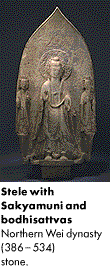 |
 |
 |
 |
 |
 |
 |

The popularity of Buddhism during the Northern Wei period
is reflected in the spread of art patronage through all
levels of society. This stele was sponsored by thirty-four
individuals who had their names and images incised on the
reverse. Northern Wei sculpture is hieratic in composition,
with the sanctity of the deity figures reflected in their
placement and relative sizes. In this stele Sakyamuni
Buddha is in the center flanked by two bodhisattvas who are
almost half his size. The linear description of the
garment, with its rippling folds flaring into an
exaggeratedly wide scalloped hem, indicates that the
sculptor incorporated traditional Chinese artistic idioms
and style into a sculptural art that originated outside
China. In symbolic gestures Sakyamuni reassures the
faithful that their wishes will be granted and their fears
set at rest. |
 |
 |
 |
 |
The pictorial complexity and
extraordinarily rich iconography of this stele suggest that
it was made a few centuries after Buddhism was introduced
to China. During the sixth century, the Chinese state of
Liang, in present-day Sichuan Province where this stele was
found, had close ties with India and Southeast Asian
countries through trade and diplomatic and religious
missions. Sculptural images in various mediums from the
Indian Gupta kingdom (4th-6th centuries), brought back by
returning monks and merchants, exerted significant
influences on the style of Chinese Buddhist sculpture. The
sensuous modeling and suggestion of movement in the figures
reflect this conscious process of artistic borrowing. The
landscape settings for Buddhist narratives on the back of
the stele are particularly noteworthy. In the lower half of
the stele, mountain forms, rocks, and trees create "space
cells" within which the figures and other narrative
elements are placed. This is an example of an early stage
in the continuing efforts of Chinese artists to represent
three-dimensional landscape space convincingly on a
two-dimensional picture surface. A very early experiment in
three-point perspective can be seen in the architectural
setting depicted in the upper part of the stele. |
 |
 |
 |
 |
In a long inscription
engraved on the pedestal of this gilt bronze altar made for
a private home, the lay devotee Dong Qin states that he
commissioned the image of Amitabha for the protection of
the emperor, the empress, and members of his family.
Amitabha, the Buddha residing in the Pure Land of the West,
receives into paradise the faithful who invoke his name.
There, in bliss, they await their next rebirth. He is
represented in the center of a triad, with the bodhisattvas
Avalokitesvara on his left and Mahasthamaprapta on his
right. They are accompanied by a pair of divine guardians
whose bulging muscles and wide-open eyes express the potent
wrath against evil of these protectors of Buddhist Law. The
gentle fluidity and linearity of the garment folds and
scarves are features common to Buddhist stone sculptures of
the sixth century. The radiance of the gilt surface
effectively suggests the glory of Amitabha's Western
Paradise. The thorough fusion of influences into a fully
sinicized style is evident in the just proportions of these
figures and in the sense of motion combined with careful
symmetry. |
 |



